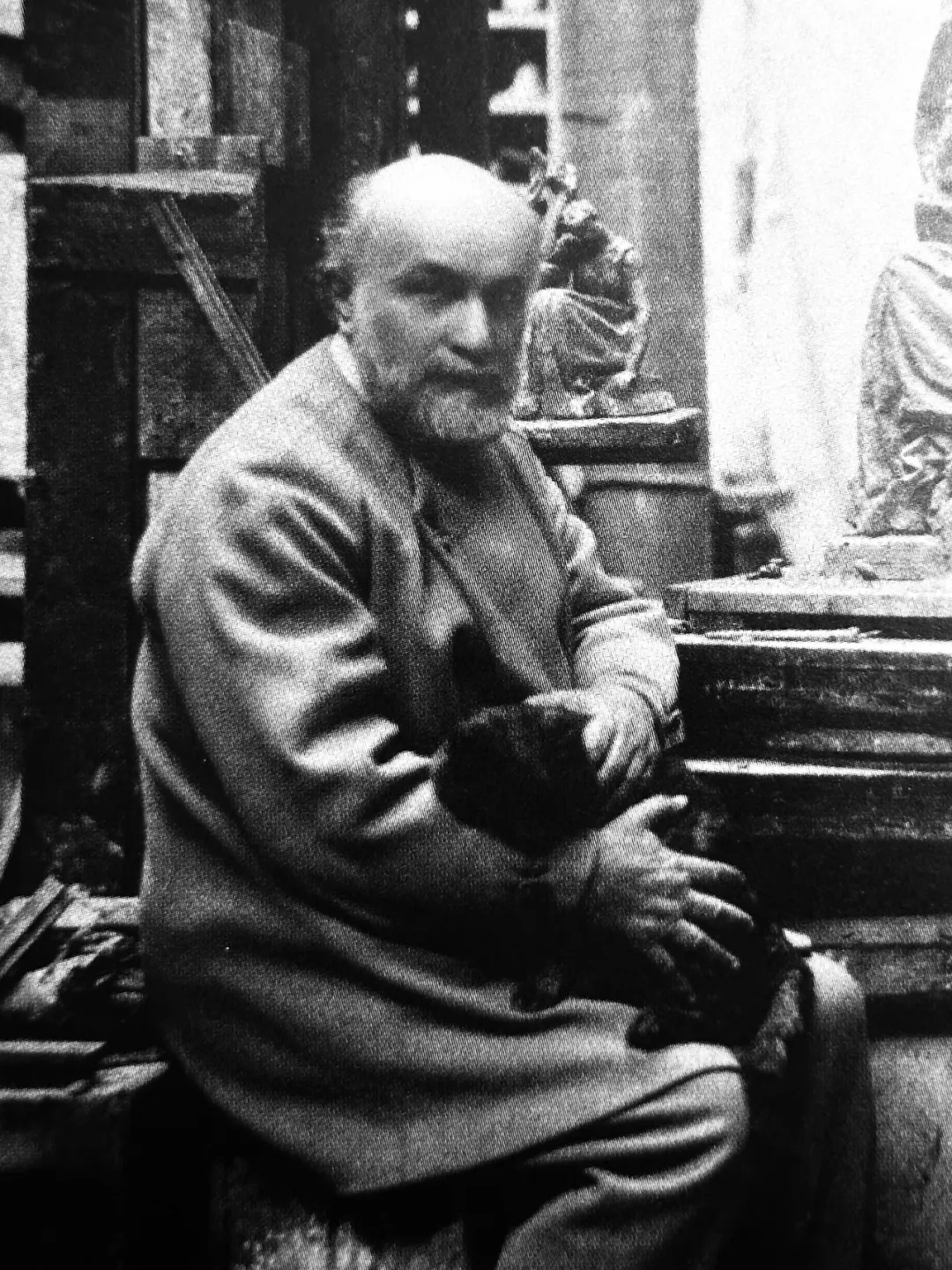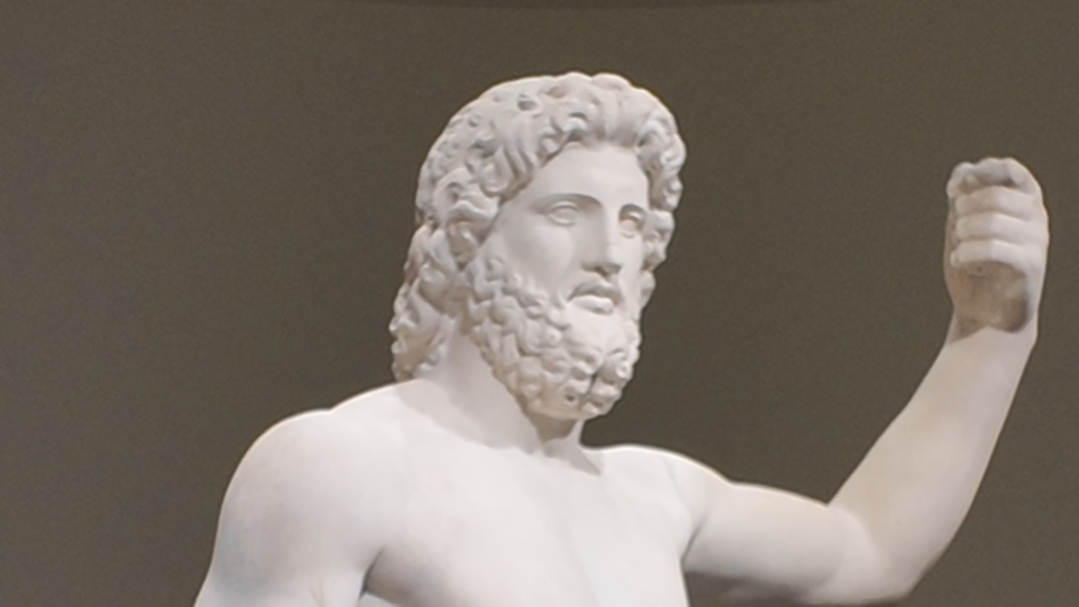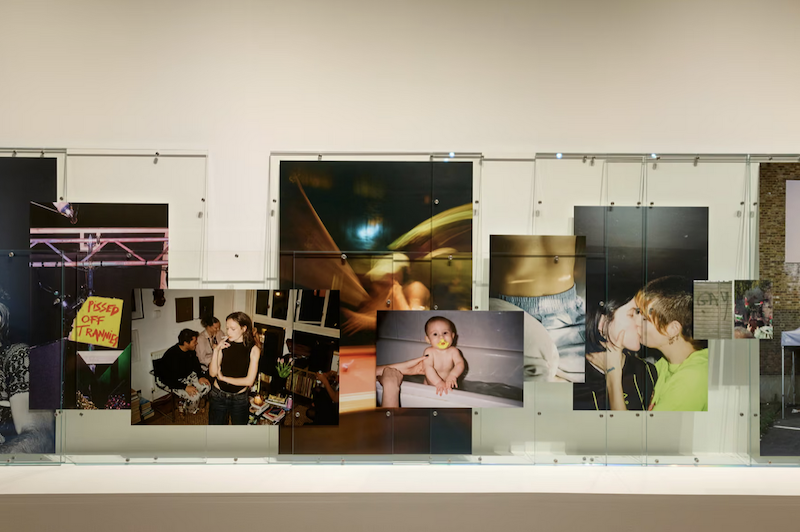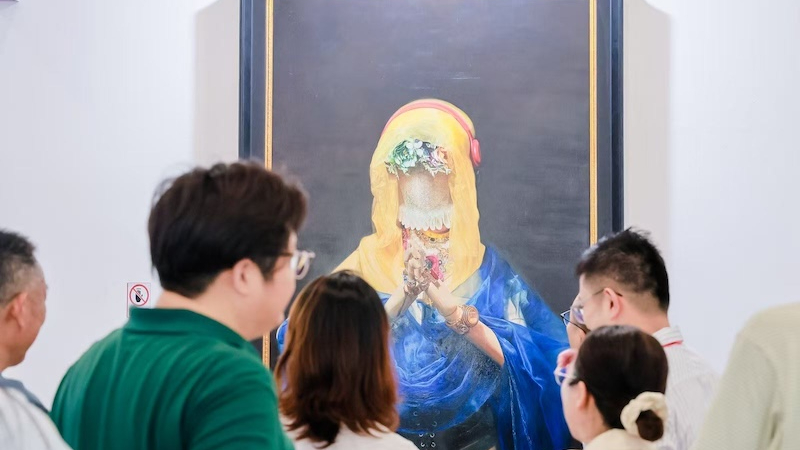
In Paris, where museums are dotted everywhere, the Bourdelle Museum does not have the hustle and bustle of the Louvre, the liveliness of the Orsay Museum, or the photo-taking spots of the Eiffel Tower, but it makes people feel close because they can quietly step into the real world of a great artist.
French sculptor Emile Antoine Bourdelle (1861-1929) is one of the most influential sculptors in the 20th century. As a student and assistant of Rodin, he is also a true poet and an artist with a heart full of passion. He trained Wu Dayu during his study in France and influenced Zhang Gongqu. This article is a record of the author's visit to the Bourdelle Museum in Paris.

Emile Antoine Bourdelle (1861-1929)

Bourdelle "The Great Warrior" Bronze
Emile-Antoine Bourdelle (1861-1929) played a key role in shaping the language of modern sculpture. His works, with their architectural power, brought new expressiveness and structural depth to modern art, thus setting the direction for public and monumental sculpture.
Bourdelle was born in Montalban, a city in southwestern France. His early career was deeply influenced by classical and medieval art forms. However, his work as an assistant to Rodin from 1893 to 1908 helped him mature as an artist. He absorbed Rodin's emotional tension and rich surface texture, while also gradually developing his own unique artistic style, which was more inclined towards structural rigor, symbolism and mythical grandeur. One of Bourdelle's important achievements was his redefinition of "large sculpture". In an era when public statues were becoming more formal and stereotyped, he gave them bold, mysterious and psychological qualities.
On June 5, 2025, I came to Paris to visit Bourdelle's garden courtyard museum, bringing with me the book "The World According to the Artist", which was compiled based on Bourdelle's thoughts on life and art. This book is the Chinese translation of the 1990 edition. I have kept it in my attic since then. It is an "art treasure book" that I often read and studied in my youth. Now I occasionally flip through it and get new discoveries and enlightenment.
This is my second visit to the Musée Bourdelle. Last time, its plaster model hall was still under renovation and not open to the public. This time, it has been renovated. For me, visiting the Musée Bourdelle is also an "art pilgrimage". It trained Wu Dayu during his study in France, influenced my teacher Zhang Gongqu, and also has my memories of learning painting when I was a child...

Full-scale plaster model of the lobby entrance

Bourdelle's bronze "Warrior with Sword" is considered one of the three pillars of European sculpture along with Rodin and Maillol.
In the long history of Western art, the late 19th century to early 20th century was a critical period of great changes in sculpture art. In that era, the rise of three French artists reshaped the face of sculpture and laid a solid foundation for modern sculpture. They were Auguste Rodin (1840-1917), Antoine Bourdelle and Aristide Maillol (1861-1944).
The three sculptors not only responded to each other in style, but also formed a relationship of inheritance and dialogue in the position of art history. Rodin broke the tradition and opened the door to modern sculpture; Bourdelle built a bridge between tension and monumentality; Maillol developed in the direction of formalist simplification... Together, they established that sculpture is no longer a classical replica, but a modern art form with creative expression and independent value. Whether it is the pursuit of emotion, power or formal beauty, although the three have different artistic styles, they have paved the way for the development of sculpture in the 20th century, and jointly promoted sculpture to break free from the constraints of classicism and move towards a freer and more individualized artistic expression, which directly influenced the subsequent generation of art masters such as Henry Moore, Brancusi, and Giacometti.
Rodin, the master of the revolution in sculpture, was already a giant in the art world when Bourdelle entered his circle. When Bourdelle entered the studio, he was already trained and had a unique style, based on heroic, architectural forms, inspired by both ancient Greek sculpture and Gothic architecture.
Rodin appreciated Bourdelle’s talent and granted him a freedom rarely seen in a mentor-apprentice relationship. Bourdelle worked on several of Rodin’s major works, including the Monument to Victor Hugo, but always maintained his own creative practice. This dual role, as both collaborator and independent artist, allowed Bourdelle to absorb Rodin’s expressive energy while forging his own more rigorous and monumental artistic language.
While Rodin’s sculptures were devoted to direct expression of emotion and the illusion of movement, Bourdelle sought clarity, power and grandeur, and their different aesthetics did not conflict, but rather enriched their respective works. Rodin’s emphasis on the dynamism of form impressed Bourdelle, who incorporated it into his own pursuit of sculptural purity and symbolic power. Bourdelle’s Hercules with the Bow (1909), perhaps his most representative work, embodies this fusion. The muscular tone and linear dynamism of the figure reveal the influence of Rodin, but the overall structural rigor, mythological color and heroic spirit are clearly different from Rodin’s turbulent surface effects, emphasizing the "architectural" and "monumental" nature of the sculpture.

Bourdelle: Hercules with the Bow, bronze
Although the young sculptor later declared his independence, Bourdelle and Rodin maintained a relationship of mutual respect. Although Bourdelle was determined to forge his own path, he always acknowledged that Rodin was a crucial influence. Their relationship was not one of imitation, but evolution. Bourdelle inherited Rodin's innovations and built on them, creating a new sculptural language that bridged Rodin's nineteenth-century romantic style and the emerging abstraction of the early twentieth century. The connection between Rodin and Bourdelle represents one of the most important artistic dialogues in modern sculpture. Through their intertwined legacies, both artists helped to redefine the possibilities of sculpture and left an indelible mark on the history of modern art.
By the time Bourdelle left Rodin’s studio, he was already an influential sculptor and later a respected teacher at the École de la Grande Chaumier, training future masters such as Henri Matisse, Alberto Giacometti, and Vera Ignatievna Mukhina, all of whose names I found on the wall of the museum’s École de la Grande Chaumier student list.
"Bourdel is the ideological mentor of an entire generation. He helps and guides his students to discover the path and source of their own artistic creation, and teaches them freedom and courage, sufficient self-confidence, and a frank and magnanimous mind in their creation. He encourages them to discover and use their own genius to create and open up an infinitely developing art field, and cultivates their adherence to the principles of artist thinking and their true and tireless spirit of exploration of nature."

Studio photo of the Grand Chaumiers Institute

Student Wall of Grand Chaumiers College

Giacometti's "Diego in a Wool Jacket" and Mukhina (former Soviet Union)'s "Worker and Collective Farm Girl" Bronze
I remember that in the late 1980s, every Sunday afternoon, I would go to my teacher Zhang Gongqu's home on Wuyuan Road in Shanghai to ask for advice. Once when we talked about European sculptures, he suddenly asked me, "Who do you like better, Rodin or Bourdelle?" I forgot how I answered at the time. I was in my teens at the time and I might have answered "I like both." Teacher Zhang continued, "I prefer Bourdelle because his sculptures are more powerful!"

Plaster cast of Bourdelle's Hercules with the Bow

Bourdelle and the model working on "Hercules with the Bow"
Then we talked about Bourdelle's famous sculpture "Hercules Drawing the Bow". Teacher Gong said that the figure drawing the bow is full of "momentum and power". The two legs bent and kneeled and the arms straight and bent form the moment of drawing the bow. Although the arm is holding the bow, there is no string and no arrow, which makes the "empty" space here full of imagination and creates infinite tension, solidifying the moment when the mythical hero accumulates power to shoot the arrow into a shocking energy. Then, he told me a fable about "shooting without shooting" in Zhuangzi's "Lie Yukou shoots for Bo Hun without anyone". At that time, I happened to watch the Shanghai Animation Film Studio's animated film "shooting without shooting" adapted from Zhuangzi's story. The sentence at the end of the film "the ultimate action is not to do, the ultimate words are no words, the ultimate shooting is not to shoot, and the shooting without shooting" points out the highest philosophical realm of skills and Tao.
Teacher Gongqu said: "Bourdel's sculpture of a man drawing a bow and Zhuangzi's fable made me realize that my paintings can also be 'paintings without painting'". Therefore, as early as the 1950s, Zhang Gongqu often talked about the philosophical views of Laozi and Zhuangzi in his exchanges with his teacher Wu Dayu. Under the influence of Laozi and Zhuangzi's thoughts, Master Gongqu's artistic ideal of "painting without painting" was established. The painting focuses on blank space and leaving blank space, so that the empty space can also gather strength. In addition, the power and changes of the brushstrokes make the painting ever-changing, rather than just a fixed depiction object, so that the art expression has concrete modeling in abstract forms, and abstract meaning in concrete modeling...
In the book "The World as Seen by the Artist", Bourdelle mentioned "generalization" many times, "generalizing" the laws from ancient art, "generalizing" the beautiful forms from nature, and even the works of art themselves need "generalization". This reminds me of Mr. Wu Dayu, who was nicknamed "Wu Dati" by his many students because his most common catchphrase in classroom teaching was "grasp the general idea". He required students to have a sense of the whole when painting, and not to pursue fragmentary details and show off skills at the beginning of painting. He emphasized that they should not be blinded by trivial details, but should grasp the overall structure and inner spirit of the picture.
Wu Dayu's understanding of Bourdelle's structural law of "architecturality" has been transformed into a strong sense of "construction" in his paintings. In his late abstract works, those unrestrained and powerful brushstrokes are not randomly splashed, but are precisely "constructed" on the canvas like an architect - strong and heavy blocks of color squeeze, push and support each other, as if competing and balancing in the plane space. The viewer can clearly perceive the carefully structured and vigorous "momentum" inside the picture. The "momentum" in his paintings is the perfect crystallization of the Western rational structural consciousness emphasized by Bourdelle and the lively and vigorous writing spirit of traditional Chinese art.

"Wu Dayu" on the student list wall
I found the name "Wu Dayu" on the wall of the list of students from all over the world at the Grand Chaumier Academy of the Bourdelle Museum. In the spring of 1922, Wu Dayu went to France to study at his own expense. After studying French for half a year, he was admitted to the National Higher School of Fine Arts in Paris. In 1923, he transferred to Bourdelle's studio at the Grand Chaumier Academy to study. The Grand Chaumier Academy was founded in 1904 and began to grow in 1909. Bourdelle was invited to teach sculpture courses. He came once a week to correct the students' works created with nude models. Here, he cultivated students' observation and thinking abilities, as well as the awakening of eyes and hearts, and taught the practical foundations of painting and sculpture, focusing on the analysis of human structure. In addition, visits to museums and art exhibitions were arranged. His unique teaching method and international perspective courses were open to beginners and senior artists. From such a rich resource library, he also recruited assistants.
While studying at the Collège des Grands Chaumiers, Wu Dayu personally experienced Bourdelle's teachings, which not only laid the foundation of modernist thought for his subsequent painting creations, but also gave him the concept of modern art education. After returning to China, Master Dayu served as the director of the Western Painting Department of the National Art College in Hangzhou. By enlightening the minds and lighting the eyes, he cultivated a group of outstanding painters with modern thoughts and consciousness. In addition to Zhang Gongqun, his students also included Zao Wou-Ki, Chu Teh-Chun, Wu Guanzhong, Ding Tianque and others. He is respected as the master of Chinese modernist painting and the founder of modern art education.

Bourdelle at work (file)

The gardens and promenade of the Bourdelle Museum

Garden Courtyard Sculpture Museum
"The Musée Antoinette Bourdelle is the most beautiful and elegant art palace located in Montparnasse, Paris. In the exhibition halls that were once the studios of the sculptors, in the quiet, secluded courtyards with flowers and plants, under the deep shade of the ancient chestnut trees in full bloom, and in the art galleries facing the endless blue sky of Paris, Bourdelle's name and his works will always release charming brilliance.
Here, we can see the extraordinary artistic impact of the sculptures created by this master! "Benelope" has the graceful and elegant proportions of classical sculptures. It shows the human body movement of a woman in a dream, with her head gently leaning on her arm, and depicts a beautiful and even body. Another group of masterpieces, "Power", "Eloquence", "Freedom" and "Victory", stand proudly around the "Monument to General Avil". "Meckles with the Bow" has a solemn and magnificent momentum and power, full of heroic spirit. This wonderful work is the product of his artistic inspiration and creative passion in his youth. Hercules is ready to shoot his invisible and fatal arrow towards the vast and lofty sky. The great and immortal soul of music, Beethoven, is bowing his head and listening to the call from the depths of his soul. When disaster strikes and pain knocks on the door of his destiny, he strangles the throat of destiny with his superhuman will. On his sad face, there flashed a wild and tenacious look, which, along with his restless soul, was forever cast in the pain of bronze and carved in the noise of marble..." - This is the scene of the Bourdelle Museum and Bourdelle's sculptures described in "The World in the Eyes of the Artist", and it is also the place I have been thinking about for so many years.

The original studio is preserved

A corner of the original studio preserved
This museum consists of Bourdelle's former residence and studio, where he lived and worked from 1885. After his death in 1929, his family and friends donated his studio to the Paris City Government, which was opened to the public as a museum in 1949. Today, it not only exhibits a large number of Bourdelle's sculptures, sketches and paintings, but also preserves his original workplace and living space. The wooden ceiling, tall windows and clay drafts and plaster statues scattered throughout the room make people feel as if they have traveled through time and space, placed themselves in the inner world of an artist, and felt the charm and energy of the master's artistic creation.
Although I have been to Paris many times in the past ten years, I have never had the opportunity to visit the Bourdelle Museum, either because I did not have enough time or because it was temporarily closed when I arrived. When I came in 2023, the museum was open, but the full-size plaster model hall was still under renovation, which left a regret. This visit had plenty of time and the entire museum was open. Not only could I easily and carefully view the various exhibition halls and gardens, I also sat down for afternoon coffee in the Le Rhodia restaurant in the museum. This was originally the old apartment of Bourdelle's daughter, Rhodia Dufet-Bourdelle. This space was transformed by the decorative art master Michel Dufet in 1947, overlooking the museum's internal garden. It was later redesigned and is now a large L-shaped terrace and indoor restaurant.
In Paris, where museums are like stars, the Bourdelle Museum is not as bustling as the Louvre, not as lively and charming as the Orsay Museum, and not as photo-taking spot as the Eiffel Tower, but it does make me feel very close, because it allows me to quietly walk into the real world of an art master. The plaster model hall is as majestic and open as a majestic palace, the studio is as crude and simple as the master just put down the tools with plaster in his hands, and the various bronze statues in the courtyard garden are casually placed and staggered... Walking between the museum garden and various exhibition halls, those large and small sculptures of different materials cast deep shadows under natural light, as if whispering the story of the times and soul. Bourdelle's art and thoughts focus on human destiny and emotions, and are upright, elegant, solemn and magnificent, and pursue spiritual sublimation. This slightly low-key museum carries the weight and glory of sculpture art, quiet and full of power!
Here, I experienced a silent and profound dialogue. There was no exaggerated noise, only a sincere gaze with art and a resonance of the soul, which was silent but deeply rooted in my heart.
"I always maintain a soul that dominates dreams. Our lives are rich and profound, and the inner spiritual life of human beings depends on our deep understanding of our own power" - said Bourdelle.
June 27, 2025

Bourdelle's Death of Sandro, plaster

Bourdelle's "Sword of Poland" plaster

Bourdelle's Benelope plaster

Bourdelle's "Memorial to General Aville" plaster

Bourdelle's Victory plaster

Panorama of Bourdelle's studio

Bourdelle's studio scene

Bourdelle's studio scene

Bourdelle's studio scene

Various Bourdelle sculptures on display

Bourdelle sculptures on display

Bourdelle sketch line drawing

Study for the frescoes at the Theatre des Champs-Elysées in Bourdelle / paint on cement
(The author is a researcher at the Center for Modern and Contemporary Art of East China Normal University and a visiting professor at the Shanghai Academy of Visual Arts)


